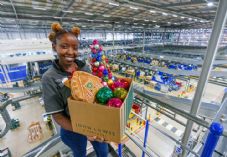UK DIY News
Waitrose & John Lewis Plan Switch To Electric Deliveries

Waitrose and John Lewis have announced plans to significantly increase the use of electric vans to help fulfill its ambition of ending the use of fossil fuels across its entire transport fleet by 2030.
The John Lewis Partnership will use two new designs of vehicle for its Waitrose.com food deliveries and for smaller John Lewis deliveries, saving over 20,000 tonnes of CO2 every year, equivalent to the carbon footprint produced by 2,500 UK households.
The electric vans follow the retailer’s recent announcement that it is building a dedicated biomethane gas filling station to enable its largest heavy goods vehicles to use a low-carbon alternative to diesel. This will reduce CO2 emissions by 80%, with each truck saving over 100 tonnes of CO2 every year.
Highlighted in the retailer’s Ethics & Sustainability Progress Report, published today, the revolutionary electric vans will be trialled early next year. The retailer has worked with manufacturers and data scientists to source vehicles that are the most efficient and environmentally-responsible.
In addition to producing fewer pollutants, the state-of-the-art electric vehicles have greater capacity than their diesel counterparts. In some cases, this means replacing three diesel vans with two electric ones. Electric vans are also quieter which is important for reducing noise pollution in built-up areas. The vehicle can also be upgraded as technology advances, meaning the electric vans could have a very long life of up to 20 years or more. This is a significant benefit that really adds to the sustainability of the vehicle.
Justin Laney, Partner & General Manager of Central Transport at the John Lewis Partnership, says: “As our online services rapidly expand, we’re working hard to meet our goal of operating a zero fossil fuel in the next ten years. Our new electric vans are an ideal solution for home deliveries; the innovative design means they’re more efficient, but also respectful to the environment and the growing number of neighbourhoods in which we deliver.”
Waitrose.com has been growing significantly in preparation for being the only place for customers to buy Waitrose products online in September. Since accelerating its online expansion in light of Covid-19, Waitrose has added more than 100,000 customer order slots each week to its service (now more than 160,000 slots each week) and has committed at least 25% of Waitrose.com orders to vulnerable and elderly customers, including those on the government lists.
Waitrose.com now delivers to nearly 90% of postcodes across the country via a network of shops and two (to be three at the end of this year) fulfilment centres in London.
The Waitrose Rapid service has also trebled its deliveries to 7,000 p/w, with at least 40% of the slots reserved for vulnerable customers. The service offers up to 25 products for delivery within two hours.
The Partnership’s Ethics & Sustainability Progress Report also details the retailer’s commitment to increasing the number of electric vehicle charging points for customers and Partnership vans in its shop car parks.
In March 2019, the employee-owned business pledged to be net zero carbon across its entire operations by 2050 at the latest. The retailer has already announced that it is building a dedicated biomethane gas filling station to enable its largest heavy goods vehicles to use an alternative to diesel. Serving approximately 120 Waitrose heavy goods trucks, the vehicles will run on biomethane made from food waste and food processing waste materials rather than diesel. Over the next seven years, the Bracknell site alone will save over 70,000 tonnes of CO2 as a result of the biomethane gas trucks.
Source : John Lewis Partnership
Insight DIY always publishes the latest news stories before anyone else and we find it to be an invaluable source of customer and market information.











































